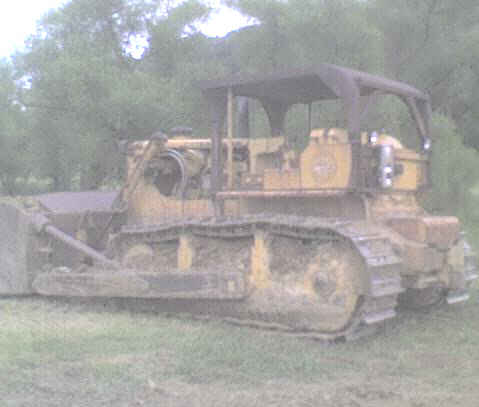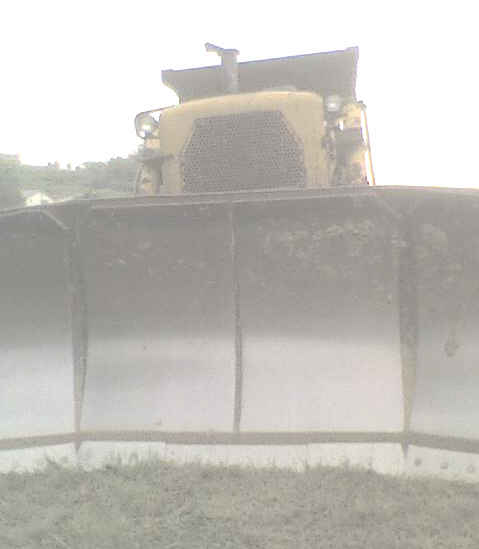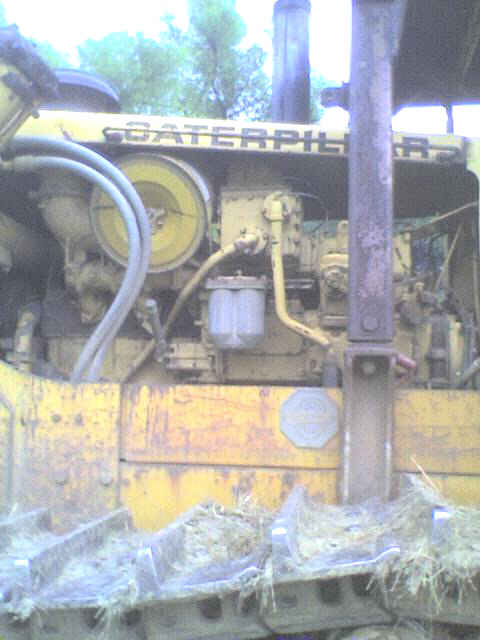The Massive &
Overwhelming Caterpillar
D9 Bulldozer
|
|
The Caterpillar D9 Bulldozer
By: The Working Man
For decades the largest earth moving bulldozer around was
the Caterpillar D9 bulldozer. A massive amount of metal
that could move massive amounts of earth or materials.
The D9 dozer became what one thought of when thinking
of huge pieces of heavy equipment and for good reason.
In 1954 Caterpillar introduced 10 models for testing
that were to become the new D9 machine, they were
modeled D9X (x for experimental).
The following year the 286 hp D9 dozer came on the market
powered by Cat's D353 engine which stayed in the machine
until 1980 when Cat upgraded the D9 to the D9L, although
in 1956 the engine was remanufactured to produce 320 hp.
An older D9 resting after a days work excavating for a gas well

See more Pictures of CatD9 Bull Dozers
Here
| Model |
Year Started |
Horse Power |
| D9 |
1955 |
286 |
| D9E |
1959 |
335 |
| D9G |
1961 |
385 |
| D9H |
1974 |
410 |
| D9L |
1980 |
460 |
| D9N |
1988 |
375 |
| D9R |
1996 |
405 |
| D9T |
2004 |
410 |
It got a little cold for the operator in the winter. The D9
offered little in the way of operator comfort, it was just
one huge piece of moving metal that moved huge amounts of
material and destroyed anything and everything in it's
path. When it got really cold, they would turn the fan
around so the hot air from the engine being cooled
would blow back into the cab area. This was all right,
but there was no climate control, it was either full
on or nothing. If the operator got too warm, he had
the only other option of shedding clothes.
Today's D9 dozers with cabs give full climate control
along with a much more comfortable seat, the cab reduces
noises to a considerable degree and there's even
a radio and CD player.
A early D9's Cab

When Caterpillar introduced the elevated drive
sprocket on it's D10 bulldozer, the D9L was the
first of the 9 series to follow suit. It was later
added to the D8 and D7 series of dozers. You
can read more about the elevated sprocket design
on our page about the Caterpillar D10.
Cat D9 with Elevated Sprocket Design

The current D9T sports new Cat C18 ACERT engine
which uses state of the art technology to increase
power and reduce emissions. They use a cross flow
cylinder head to increase air into the combustion
chamber, water cooled turbochargers, mechanical -
electronic controlled injection system which
delivers micro blasts of fuel just prior to and just
after the main injection and a computer controlled
fuel injection process.
The Cat C18 ACERT engines are also used to power
yachts, tugboats, and various other heavy equipment
like the Cat 637G and 657G self propelled wheel scrapers,
772F quarry truck, 836H landfill compactor,
the 24M motor grader, 834H wheel dozer,
988H wheel loader and 385C L Series excavator.
Caterpillar also uses the C18 engine in it's
Cat Challenger MT865B, MT875B and MT965B
and MT975B which is the world's largest
4 wheel drive farm tractor clocking in at 570
horse power. The MT875B also had 575 HP but was
a track type tractor.
Depending upon application the C18 ACERT engine
is available in a wide range of horse power to suit needs.
The D9T Cat C18 ACERT engine is a 6 cylinder inline
turbo charged engine delivering 410 horsepower.
Cat C18 ACERT Engine

The D9T has 410 HP and weighs 105,600 lbs.
In comparison, a D10T has 580 HP and weighs
146,500 lbs, where the D11T has 850 HP, weights
230,100 lbs.
There are 3 different blades available for the D9:
1. A straight blade which is used for grading.
2. A universal blade which is taller and curved
along with side wings to push bulk material.
3. A combination blade which is shorter, less curved
and smaller side wings.
A Cat D9 Blade in all it's Awesomeness

There is also a ripper attachment than was available
as an option on the D9. It is attached to the rear of
the machine and used for tearing up hard and
frozen surface areas. The ripper can penetrate up
to 5 and 1/2 feet into some surfaces. The second option
for a rear attachment was a winch.
The D9 machines were mainly used for strip mining
removing overburden, clearing right of ways, and road
construction.
It became apparent that Caterpillar needed a larger
machine to replace the D9. Other manufacturers already
had larger machines on the market and market economics
looked good.
In March 1977 Caterpillar sent 10 machines out to
different jobs performing different kinds of work.
After extensive testing, these machines numbered,
P-1 to P-10 would become the Caterpillar D10
which could perform about 50% more work in a day
than the D9H.
When the Cat D9 dozer came out in the 1950's the
price was right around 1 dollar a pound, or with
the original D9's weight of 49 tons, the cost would
have been around $50,000. Today the cost of a new
D9T is right around $900,000.
The engine of a D9

Killdozers and CaterKillers
The made for Television movie entitled "Killdozer"
was broadcast in 1974 as part of ABC's suspense
movie of the week.
A group of construction workers build an airstrip on
a South Pacific Island where their D9 dozer hits
a meteorite that has a strange alien life force in
it. The life force is transferred to the D9 and
the D9 takes on a life of it's own, attempting to
kill all the workers on the island.
Find out more about the movie Killdozer here.
The Israeli Army purchased D9's in the 1960's and
added armor plating along with machine guns and
grenade launchers turning the D9 into a tank
of sorts, complete with manned crew. Israel
uses the Armored D9 to raze Palestinian houses,
intimidate their foes and uproot precious trees and
destroy landmarks and agricultural areas.
this machine has been called various names including
"caterkiller."
Much bad press has been given to the Caterpillar
corporation for allowing the sale of the D9 machines
to Israel.
The United States armed forces has used D9 bulldozers
for clearing land during the Vietnam War and in the
war in Iraq. These machines were not modified to any
degree to make them into tanks, but were basically
as was from factory, only with different paint schemes
than the traditional Cat Yellow. The Army has bought
several "armored kits" from the Israeli's and used
them to modify several D9's, but have not used them
as weapons on a battlefield.
Back to Index of All Heavy Equipment
|